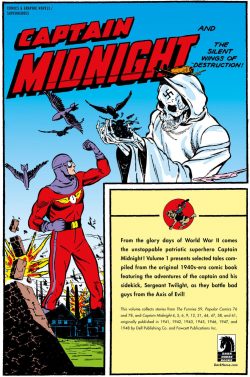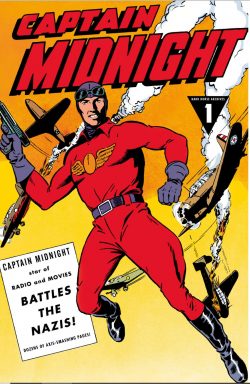

By Dave Gormley, Leonard Frank, Carl Pfeufer, Dan Barry & anonymous & various (Dark Horse Comics)
ISBN: 78-1-61655-242-8 (HB) eISBN: 978-1-62115-884-4
Captain Midnight began his bombastic life as a radio serial star in the days when two-fisted, troubleshooting aviators were the acme of adventure genre heroes. Created by broadcast writers Wilfred G. Moore and Robert M. Burtt, the show was conceived by Chicago ad-men to promote Skelly Oil in the American Midwest.
The Captain Midnight Program soldiered on from 1938 to 1940 until the Wander Company acquired the sponsorship rights to promote their top product: Ovaltine. From there on, not even the sky was the limit: national radio syndication led to a newspaper comic strip (by Erwin L. Hess, running from June 29th 1942 until the end of the decade); a movie serial (1942) and – later – two TV serials (1953 and 1954-1956 – but syndicated as “Jet Jackson, Flying Commando” well into the 1960s). There was also a mountain of merchandise such as the legendary Captain Midnight Secret Decoder Ring…
There was also a comic book franchise or more accurately two…
The core premise was that after World War One ended, pilot/aviation inventor Captain Jim Albright returned home having earned the sobriquet “Captain Midnight” after a particularly harrowing mission that concluded successfully at the witching hour. Founding a paramilitary “Secret Squadron” of like-minded pilots, he did good deeds – often at the covert behest of the President – employing guts and gadgets to foil spies, catch crooks and defend the nation.
Captain Midnight really hit his stride after the attack at Pearl Harbor, becoming an early Home Front media sensation. However, his already fluid backstory and appearance underwent a radical makeover when he switched comic book horses in mid-stream.
This stunningly engaging full-colour collection gathers tantalising snippets from the vast comicbook canon of the “Sovereign of the Skies”, rather arbitrarily collected from Dell Comics anthologies The Funnies #59 (September 1941) and Popular Comics 76 & 78 (June and August 1942) as well as Fawcett Comics’ Captain Midnight #4-6, 9, 12, 31, 44, 47, 58 and 61, released between January 1943 and March 1948. The solo title was initially released fortnightly with #1 bearing a September 30th 1942 cover-date.
Much of this material is unattributed but amongst the regular writers were Joseph J. “Joe” Millard, Wilford Hamilton Fawcett, Bill Woolfolk and Otto Binder whilst artists included Jack Binder and his art stable, as well as the engagingly workmanlike Leonard Frank, Carl Pfeufer, Ken Bald, Jack Keller, Sheldon Moldoff and – latterly – young but constantly improving legends-to-be Leonard Starr and Dan Barry.
Following a fond appreciation and passionate reminiscences from David Scroggy in his effusive Introduction, the cartoon classics begin with an action-packed but confusing chapter from The Funnies #59. Here Dave Gormley depicts the Captain – still clad in regulation leather jacket, aviator flight cap and goggles – and his Secret Squadron in pursuit of nefarious archenemy Ivan Shark before Popular Comics #76 finds them battling to prevent the insidious Ivan’s airborne conquest of America.
Popular Comics #78 (with art by Bob Jenney) renews and continues that titanic struggle as Shark’s henchman Gardo rushes to his master with information that could destroy democracy forever…
When Fawcett took over the comic book license in 1942, they gave Albright a stripped-down operation, flashier gimmicks and a rather striking superhero costume. They also abandoned continued serials in favour of short complete adventures as the Sky Sovereign added Nazi and Japanese villains to his macabre rogue’s gallery.
The initial Fawcett offering comes from Captain Midnight #4 (January 8th 1943) as the sabotaging ‘Gremlins of Graham Field’– possibly illustrated by Frank? – are exposed as malevolent Nazi dwarves whilst #5 sees Albright and his ward Chuck Ramsay overseas in Alexandria proving that ‘The Beasts That Flew Like Birds’ (Pfeufer) were not ancient vampires but far more insidious and dangerous modern monsters…
Plucky mechanic and comedy stooge Icky was one of three regular holdovers from the radio roster of the Secret Squadron and eventually won his own back-up strip and codename: Sergeant Twilight.
A brace of tales from #6 begins with ‘Presenting Ichabod Mudd, Cowboy!’ wherein the homely oaf accidentally exposes Nazis masquerading as cattle rustlers in Nevada, and intent on preventing the government feeding its troops, after which ‘Broadcast of Death’ sees other Nazis jamming shortwave radio communications and morale-lifting programs… until the Captain and his crew step in.
Three tales from Captain Midnight #9 (June 1943) opens with ‘Silent Wings of Destruction’ as the Monarch of the Skies tracks down undetectable planes bombing US war production plants and discovers an astounding Nazi aviation advancement. In ‘Black Tornadoes’ a German inventor unleashes all the fury of nature against the Midwest until the Captain tracks him down, and Albright’s robotic ‘Samson the Mechanical Man’ proves a major asset after uncovering enemy agents in the lab…
Three more classics come from #12 (September 1943). ‘The Puzzle of the Flying Houses’ spots spies using cloud-cover and dwelling-shaped zeppelins to photograph military secrets whilst ‘Buy War Bonds!’ offers a breathtaking ad of the period before ‘The Sinister Angels’ suborning South American peasants and fomenting rebellion are ultimately exposed by our heroes as craftily disguised foreign agents.
A big jump to Captain Midnight #31 (April 1945) opens post-war proceedings with ‘Sgt. Twilight’s Flying School’ as lovably bumbling goof Icky is gulled into teaching a gang of wily thugs how to commit seemingly impossible crimes with aircraft… before finally wising up and lowering the boom…
Issue #44 (September 1946) heralds the resurrection of a deadly foe as ‘Return of the Shark’ sees the villain copying Albright’s latest invention to facilitate robbing planes in mid-air before a literally mad scientist forces Captain Midnight to participate in a deadly ‘Invention Duel to the Death’…
December 1946’s CM #47 tangentially addresses growing public interest in horror stories as ‘Fangs of the Werewolf’ (Frank art) sees Midnight hunt an amnesiac GI in the US Sector of newly-partitioned Germany. Here he meets maniacal Nazi holdout Storm von Cloud planning a wave of terror with his sinister Werewolf Corps commandos.
As the 1940s drew to a close technological advancement, science fiction and crime became the most popular topics for action tales, and from #58 (December 1947) ‘Test Tunnel’ uses all those elements to great effect as Shark discovers Midnight’s true identity and lays a lethal trap in Albright’s latest plane-proving system…
Wrapping up this glorious grab-bag of Golden Age goodies is a tale of dogged endurance as ‘Captain Midnight Masters Glacier Peak’ (#61, March 1948; credited to Leonard Starr, but it looks like Dan Barry to me) sees Albright embroiled in a brutal struggle between rival Arctic expeditions to claim acclaim and vast riches at the top of the world…
With an eye-popping gallery of covers by Gormley, Binder, Mac Raboy and Frank, plus mesmerising period ads and mini-features such as ‘Captain Marvel Secret Messages’, ‘Captain Midnight’s Air Quiz’, ‘Captain Midnight’s Air Insignia’ and ‘Fawcett Comix Cards’ this is a superbly engaging feast of comics history and timeless thrills.
Captain Midnight Archives volume 1: Captain Midnight Battles the Nazis ® and © Dark Horse Comics 2013. All rights reserved.
